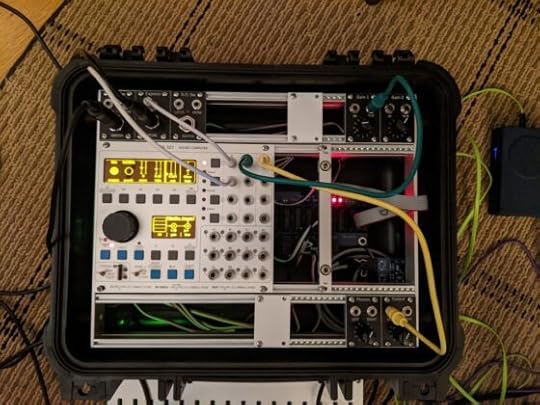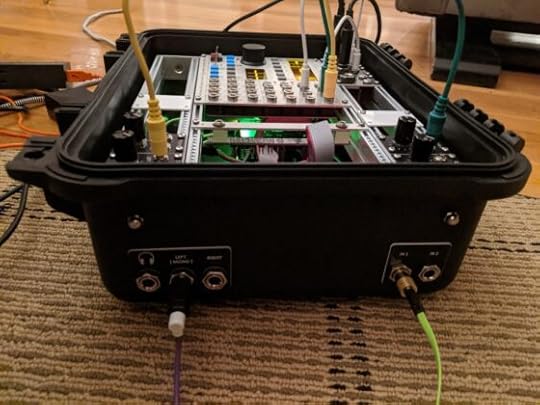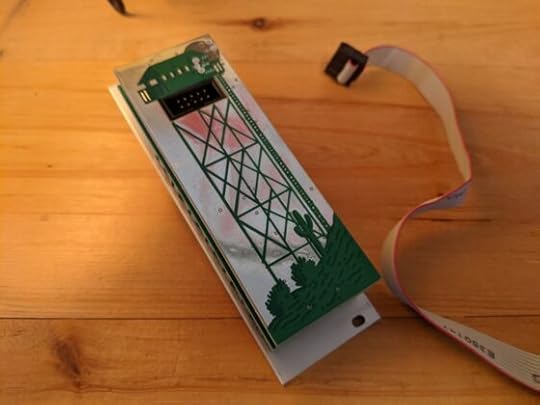Marc Weidenbaum's Blog, page 234
May 28, 2020
Disquiet Junto Silent Film Project (Update)
Over 165 people have expressed interest by signing up via the Google Form posted a couple days ago. For reference, there are currently 1,573 subscribers to the Disquiet Junto email list, and likely there is substantial overlap between the two lists. I may create a standalone list for the Silent Film project, but for now the Disquiet Junto email list will do double duty. In the next week or so, the first film and the participants for that scoring project will be announced, as will plans for subsequent films as well, at least one of which will follow shortly thereafter.
Initially the plan was maybe 20 people or so would sign up, and we’d do a single film. When that number quickly became 40, and then 60, perhaps we’d do three films at once. As the number topped 100, even allowing that many people may not end up having the time or interest when the dust settles, a more deliberate approach came into focus. There are many ways to tackle the collaborative scoring of a public domain film, and so we’ll do multiple projects over a period of time exploring those different strategies. We’ll do one in which very little information is shared. We may do one exquisite-corpse style, where each participant builds on what came before. We may do one where a shared set of sonic resources are made available. And so forth. One thing all these projects will have in common is that the participants will have substantial time to complete their work, in purposeful contrast with the standard four-day turnaround of the weekly Junto projects.
And that covers it. It’s very exciting to have the Silent Film series to cogitate on and act on during this continued state of mutual self-isolation. It is, indeed, a cliche at this stage to belabor the benefits of long-distance connection, but it is not to simply note them, especially because they have been core to the concept of the Disquiet Junto ever since it was founded back in January 2012.
Disquiet Junto Project 0439: Hybrid Self

Each Thursday in the Disquiet Junto group, a new compositional challenge is set before the group’s members, who then have just over four days to upload a track in response to the assignment. Membership in the Junto is open: just join and participate. (A SoundCloud account is helpful but not required.) There’s no pressure to do every project. It’s weekly so that you know it’s there, every Thursday through Monday, when you have the time.
Deadline: This project’s deadline is Monday, May 28, 2020, at 11:59pm (that is, just before midnight) wherever you are. It was posted on Thursday, June 1, 2020.
These are the instructions that went out to the group’s email list (at tinyletter.com/disquiet-junto):
Disquiet Junto Project 0439: Self Less
The Assignment: Compose music combining the styles of two musicians you admire.
Step 1: Think of two musicians, preferably ones with different styles, whose music you admire.
Step 2: Consider ways elements from both musicians might be combined. Elements doesn’t mean copyrighted material. It is intended to mean stylistic. (Yes, recent legal decisions have, shall we say, blurred these lines. Try to put that thought aside.)
Step 3: Compose a piece of music exploring the combination (the grafting, the hybridization) of styles you considered in Step 2.
Step 4: You may when posting your track elect to identify the musicians that served as inspiration, or you may choose to keep it to yourself.
Seven More Important Steps When Your Track Is Done:
Step 1: Include “disquiet0439” (no spaces or quotation marks) in the name of your tracks.
Step 2: If your audio-hosting platform allows for tags, be sure to also include the project tag “disquiet0439” (no spaces or quotation marks). If you’re posting on SoundCloud in particular, this is essential to subsequent location of tracks for the creation of a project playlist.
Step 3: Upload your tracks. It is helpful but not essential that you use SoundCloud to host your tracks.
Step 4: Post your tracks in the following discussion thread at llllllll.co:
https://llllllll.co/t/disquiet-junto-project-0439-hybrid-self/
Step 5: Annotate your tracks with a brief explanation of your approach and process.
Step 6: If posting on social media, please consider using the hashtag #disquietjunto so fellow participants are more likely to locate your communication.
Step 7: Then listen to and comment on tracks uploaded by your fellow Disquiet Junto participants.
Additional Details:
Deadline: This project’s deadline is Monday, May 28, 2020, at 11:59pm (that is, just before midnight) wherever you are. It was posted on Thursday, June 1, 2020.
Length: The length is up to you. This may be the rare circumstance when longer is better.
Title/Tag: When posting your tracks, please include “disquiet0439” in the title of the tracks, and where applicable (on SoundCloud, for example) as a tag.
Upload: When participating in this project, be sure to include a description of your process in planning, composing, and recording it. This description is an essential element of the communicative process inherent in the Disquiet Junto. Photos, video, and lists of equipment are always appreciated.
Download: Given the nature of this particular project sequence, it is best to set your track as downloadable and allowing for attributed remixing (i.e., a Creative Commons license permitting non-commercial sharing with attribution, allowing for derivatives).
For context, when posting the track online, please be sure to include this following information:
More on this 439th weekly Disquiet Junto project, Disquiet Junto Project 0439: Hybrid Self — The Assignment: Compose music combining the styles of two musicians you admire — at:
More on the Disquiet Junto at:
Subscribe to project announcements here:
http://tinyletter.com/disquiet-junto/
Project discussion takes place on llllllll.co:
https://llllllll.co/t/disquiet-junto-project-0439-hybrid-self/
There’s also a Disquiet Junto Slack. Send your email address to twitter.com/disquiet for Slack inclusion.
Image associated with this track is from Vega A, used thanks to a Creative Commons license and Flickr. The image has been cropped, colors shifted, and text added.
May 27, 2020
May 26, 2020
The Generative Tuba
There’s a running series on the YouTube channel of user “id m theft able” that is one of my current favorite things on the internet. (I put quotes around that name simply so it’s clear where the name begins and where it ends, and also so it’s clear that the sentence constructed around the name isn’t disintegrating as you read it.) Each of the user’s videos in this series places a tuba somewhere, “with a microphone in it,” as the description always points out.
We then hear both the sound of where the tuba has been placed — along a river bank, adjacent to a waterfall, in the wind and rain, in the snow — and that sound echoing inside of (tracing the contours of, limning the deep recesses of) the tuba itself.
The footage generally runs, uncut, for about an hour. Which is to say, it doesn’t blink. YouTube is filled with nature footage. And if you spend time in the realm of ambient electronic music, there’s a lot that’s shot of battery-powered setups out in the wild. But the generative tuba is the rare drone music video that is, truly (an oft misused term), of nature.
There are 11 videos thus far: youtube.com.
Time with the Mux

This is the rear of another module I’ve enjoyed but am putting back into the pool. It’s the Befaco Muxlicer, and in many ways it did exactly what I wanted, sorting through variations, treating disparate elements as equals. But I’m going to try some other approaches to the same end, and see what comes of it. I may end up with one of these again down the road, but for the time being I’m keeping my setup fairly compact. Before sending it off, I wanted to capture its beautiful printed circuit board.
Arrivederci, Mux

This is the rear of another module I’ve enjoyed but am putting back into the pool. It’s the Befaco Muxlicer, and in many ways it did exactly what I wanted, sorting through variations, treating disparate elements as equals. But I’m going to try some other approaches to the same end, and see what comes of it. I may end up with one of these again down the road, but for the time being I’m keeping my setup fairly compact. Before sending it off, I wanted to capture its beautiful printed circuit board.
Disquiet Junto Silent Film Project (2020)
I’m writing about an upcoming project, a special one that will be apart from our regular weekly undertakings.
It’s been on my mind to do a non-weekly Disquiet Junto community project for a long time — not for all 438 weeks of the Junto’s existence, but several years. I’ve had some such projects in the planning stages, but time is always tight, and there are a lot of factors to balance.
A Junto member, Robert Precht, got in touch recently with the proposal that Junto participants each score a part of a silent film. It was an excellent idea, and one that naturally suggested itself to being applicable in a longer time span than our normal four-day window.
Details are still being fine-tuned, including which film it will be (we’ll do something from the public domain). If you’re interested in participating, please fill out the following form. Expressing interest at this stage isn’t a commitment. Once the project begins, you’ll have a roughly month to complete your part of the project.
https://forms.gle/rzBEb44asVZq4aSVA/
It’s a Google form. If for some reason you don’t want to use the form, just email me at disquiet@gmail.com expressing your interest. Thanks.
Three creative constraints are noted in the sign-up form:
No copyrighted sound (that is, copyrighted by anyone other than the individual participant) can be used in this project
No intelligible vocals can be used in this project (keeping true to the film’s silent origin).
Each individual (or act, collective, band, etc.) can only contribute one track to this project.
Once the number of participants has been set, the film will be divided into sections for the individuals to score. The length of these segments will, of course, vary to some degree. Source audio may be provided for continuity. That’s still being discussed, as are other details.
Thanks very much for your interest, and, as always, for your generosity with your time and creativity.
May 25, 2020
Buddha Machine Variations No. 36 (Glass Tiles)
Been a few days since the previous Buddha Machine Variation. The camera died, after it had stopped playing nice with audio. And I got a new, smaller synthesizer case (from Pulp Logic, who were super helpful with plotting it out). This is the first time I’ve ever used an expression pedal with my synth, thanks to one of the three tiles in the upper left corner of the box. (“Tiles” being a term for the shorter modules seen top and bottom here, above and below the ER-301 module.) Very simple little patch. Just a proof of concept. The tiny foot (well, hand) pedal is triggering the recording of a microloop (400 or so milliseconds) of the choral audio coming from the Philip Glass 80th-birthday edition of the Buddha Machine. The expression pedal is varying how much we’re hearing the inbound Glass loop, and how much we’re hearing the microloop. If you’re wondering where the Buddha Machine is sending its audio into the synth, there are jacks in the side of the case itself.
For further patch-documentation purposes, here are two shots of the synthesizer:


Video originally posted at youtube.com/disquiet. There’s also a video playlist of the Buddha Machine Variations.
May 24, 2020
Current Listens: Ayako Okamura Tunes the World
This is my weekly(ish) answer to the question “What have you been listening to lately?” It’s lightly annotated because I don’t like re-posting material without providing some context. In the interest of conversation, let me know what you’re listening to in the comments below. Just please don’t promote your own work (or that of your label/client). This isn’t the right venue. (Just use email.)
▰ ▰ ▰ ▰ ▰ ▰ ▰ ▰ ▰ ▰ ▰ ▰ ▰ ▰ ▰
NEW: Recent(ish) arrivals and pre-releases
▰ The score to the upcoming second season of Homecoming is by Emile Mosseri, who previously scored the excellent The Last Black Man in San Francisco. It opens with violins that manage to be both atonal and syrupy, and gets even better from there. If A Winged Victory for the Sullen composed a season of Westworld, this is what it might sound like. Mosseri also scored the upcoming Miranda July-directed film Kajillionaire. The first season of Homecoming had no score, in the traditional sense. Instead, it utilized the scores of dozens of other films (see Chris O’Falt’s detailed coverage back in 2018: indiewire.com), from The Parallax View (Michael Small) to The Day The Earth Stood Still (Bernard Hermann).
▰ Twenty tracks of downtempo, sample-laden excellence: Selected Instro Work(s) 17-19 II is the latest set from Philadephia-based hip-hop producer Small Professor.
Selected Instro Work(s) 17-19 II by Small Professor
▰ Take a minute and a half to listen to how Japanese musician Ayako Okamura tunes the world, finding the fundamental pitch of field recordings and accentuating the inherent music. (Presuming you, like I, don’t know Japanese, be sure to turn on the automated translation.)
▰ White Moths is a half hour of the artist known as junklight improvising in deep, often delicate melodic territory. It isn’t drone, per se. It’s drone by association.
White Moths by junklight
Back into the Cold (Mac)

Shown here is the back of the Cold Mac synthesizer module from the company Whimsical Raps. I’ve enjoyed using it, but I’m putting it back in the pool of circulating used synthesizer equipment. Before doing so, I’m commemorating its time in my modular synth with this photograph of the lovely rear of its printed circuit board.




